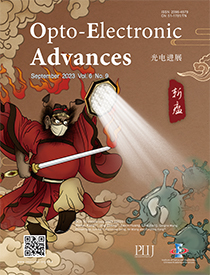2023 Vol. 6, No. 9
Cover story: Kang WY, Zheng J, Huang JX, Jiang LN, Wang QN et al. Deep-ultraviolet photonics for the disinfection of SARS-CoV-2 and its variants (Delta and Omicron) in the cryogenic environment. Opto-Electron Adv 6, 220201 (2023).
The coronavirus disease 2019 (COVID-19) pandemic has hugely affected our human society in a negative way. Deep ultraviolet (DUV) disinfection technology is one of the methods that can suppress disease transmission. However, the DUV dose reported for SARS-CoV-2 inactivation is various in the works of literature. Meanwhile, the influences from the factors of viral variants (Delta and Omicron) and low temperatures on the DUV virucidal efficacy remain unknown. Recently, the wide bandgap semiconductor research group at Xiamen University developed a high light output (3.2 W) and uniform planar light source comprised of 275-nm nitride-based LEDs according to the microorganic DUV-absorption characteristics. This light source could kill the SARS-CoV-2, H1N1, and staphylococcus aureus efficiently within 1 second. Simultaneously, the effects of mentioned two unknown factors and the principle behind them were delineated. This study reported that the lethal effect of DUV was reduced by the cryogenic environment and the variant of Omicron required a significantly higher DUV dose compared to other viral strains to achieve the same virucidal efficacy. Moreover, this study illustrated the relationship between the DUV dose and the virucidal efficacy of SARS-CoV-2 at different temperatures and provided the relevant DUV disinfection suggestion against COVID-19. The findings in this study would be significant for human society using DUV disinfection in cold conditions (e.g., the food cold chain logistics and the open air in winter).

-
{{article.year}}, {{article.volume}}({{article.issue}}): {{article.fpage | processPage:article.lpage:6}}. doi: {{article.doi}}{{article.articleStateNameEn}}, Published online {{article.preferredDate | date:'dd MMMM yyyy'}}, doi: {{article.doi}}{{article.articleStateNameEn}}, Accepted Date {{article.acceptedDate | date:'dd MMMM yyyy'}}CSTR: {{article.cstr}}
-
{{article.year}}, {{article.volume}}({{article.issue}}): {{article.fpage | processPage:article.lpage:6}}. doi: {{article.doi}}{{article.articleStateNameEn}}, Published online {{article.preferredDate | date:'dd MMMM yyyy'}}, doi: {{article.doi}}{{article.articleStateNameEn}}, Accepted Date {{article.acceptedDate | date:'dd MMMM yyyy'}}CSTR: {{article.cstr}}

 E-mail Alert
E-mail Alert RSS
RSS


